
So, when is the best time to visit Machu Picchu? This is perhaps one of the most important questions we can ask ourselves when planning a trip. With its unique climate, the best time to visit Machu Picchu may not be as evident as with other destinations.
After weighing the pros and cons of the dry, rainy, and shoulder seasons and checking the hour by hour weather forecast, you’ll find that there isn’t just one answer. The best time to visit really depends on each traveler’s personal preferences. This is why many people will tell you that Machu Picchu is a year-round destination.
Below are some key pointers for the time of day and each season to help you decide which would be the best for your vacation.
The time of day you choose to visit Machu Picchu, like everything else in this post, depends on your preferences. The ruins are open from 6 am until 6 pm, with the first bus departing Aguas Calientes at 5:30 am. Many travelers opt to get to the ruins as early as possible to get a chance to see the sunrise or hike either Huayna Picchu or Machu Picchu Mountain. Many are also just coming in from the Inca Trail. This makes mornings at the ruins the most crowded time of day. But is it worth it?
Getting to see the sunrise at Machu Picchu is a spectacular moment but also quite rare, even during the dry season. Sunrise occurs just after 6 am at that time of year. However, it is very common for morning mists and clouds to obscure the first rays of light to hit the citadel. (During the rainy season, apart from the already high chance of clouds and rain, the sunrise happens before the site even opens).
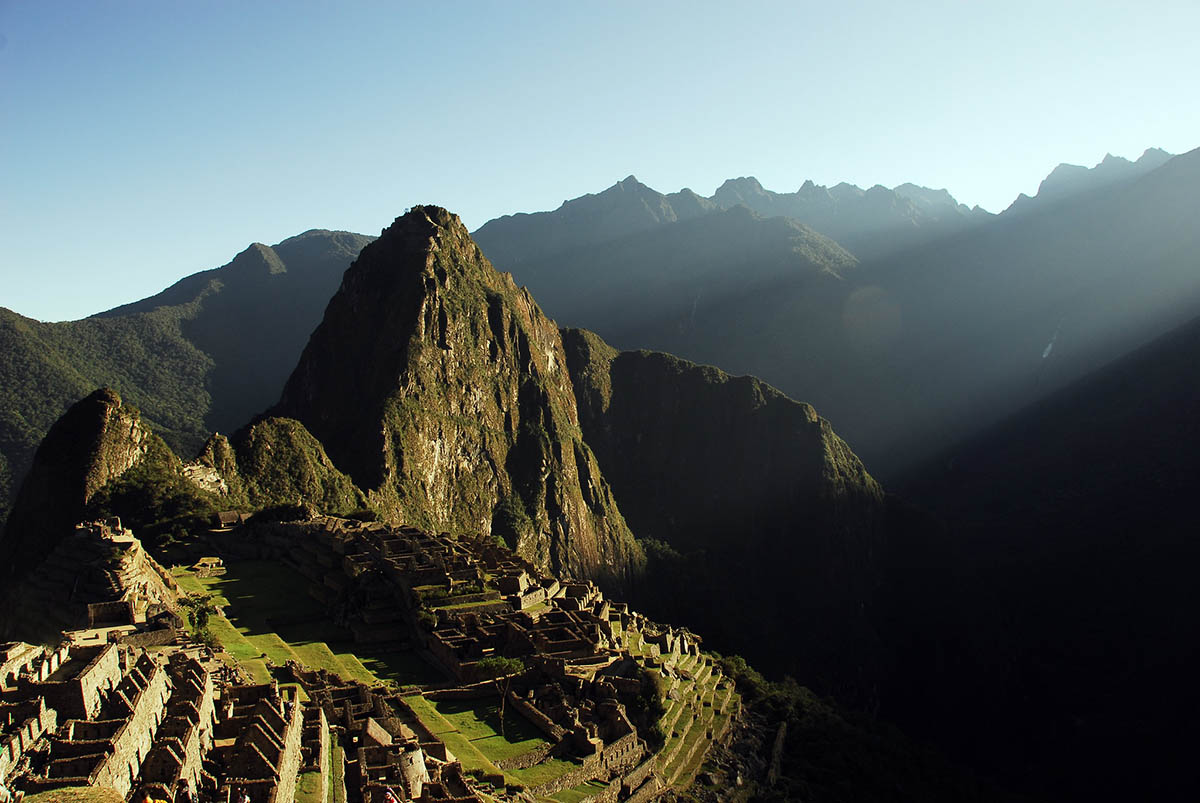
Elusive sunrise over Machu Picchu. Photo by Tinou Bao on Flickr.
During the dry season, if you do happen to get clouds and mist in the early morning, they usually clear up by mid to late morning. During the rainy season, the weather throughout the day is much more variable with clouds and rain often coming back in the afternoon.
If avoiding crowds is most important for your trip, the afternoon is the best time to visit. The logistics of visiting Machu Picchu (i.e., train times and hotel nights) make morning tours the easiest option. But if you are able to work out an afternoon visit, you will find that many people have already left for their return trip to Cusco. This means relatively smaller crowds no matter the time of year. You may also find that the golden light of the afternoon is just as magical as the soft light of sunrise. Just remember to not miss the last bus back down to Aguas Calientes departing at 5:30 pm!
Machu Picchu Tours:
The dry season, and the high tourist season, starts in May and ends in September. During these months you will have the lowest levels of precipitation, with the absolute lowest levels in June and July.
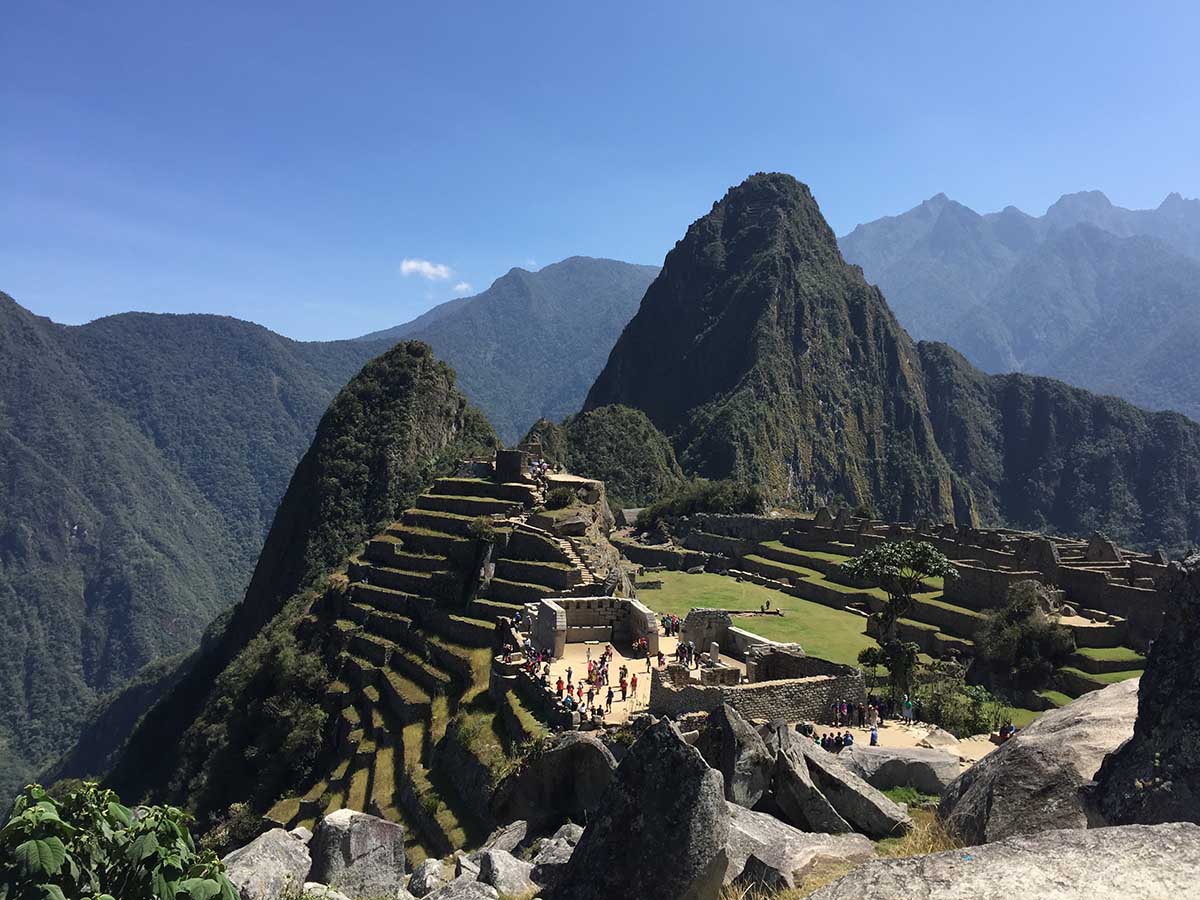
Cloudless day at Machu Picchu. Photo by Adriana Proaño from Peru For Less.
This time of year makes Machu Picchu attractive not only for nearly guaranteed sunny days but also allows families to travel during summer vacation. (Although it’s also essential to keep in mind that it will technically be winter in the southern hemisphere. This means chilly nights at Machu Picchu and throughout the Peruvian Andes).
Beautiful weather is the epitome of a vacation for many. But the downside would be the sheer number of people traveling at the same time. During the dry season, expect large crowds of people at the ruins, consequently making the background of those family travel photos a bit busy.
Packing tips:
The rainy season, corresponding to the low tourist season, falls from December to March. As the name states, these months have the most precipitation. Rainfall usually peaks in January and February. However, this time of year also sees warmer temperatures, especially at night, since it’s the southern hemisphere’s summer.
Many travelers hear the word “rain” and immediately strike the season off of their list of potential travel dates. However, most of the time the rain comes in scattered showers, and you can even experience some sunshine here and there. If you’re looking to avoid crowds—and get photos of virtually empty ruins with cool, mysterious-looking clouds—the rainy season is a great time to visit Machu Picchu. (Note, though, that there is a peak in visitors for Christmas and New Year’s).
Some key recommendations—apart from being prepared with the appropriate rain gear—is to try to schedule some extra time at the ruins just in case you can’t get that clear panorama shot the first time around. This can be a second day at the ruins if you can spare it or planning on visiting once in the morning and again in the afternoon. As the saying goes, “If you don’t like the weather, wait 5 minutes.”
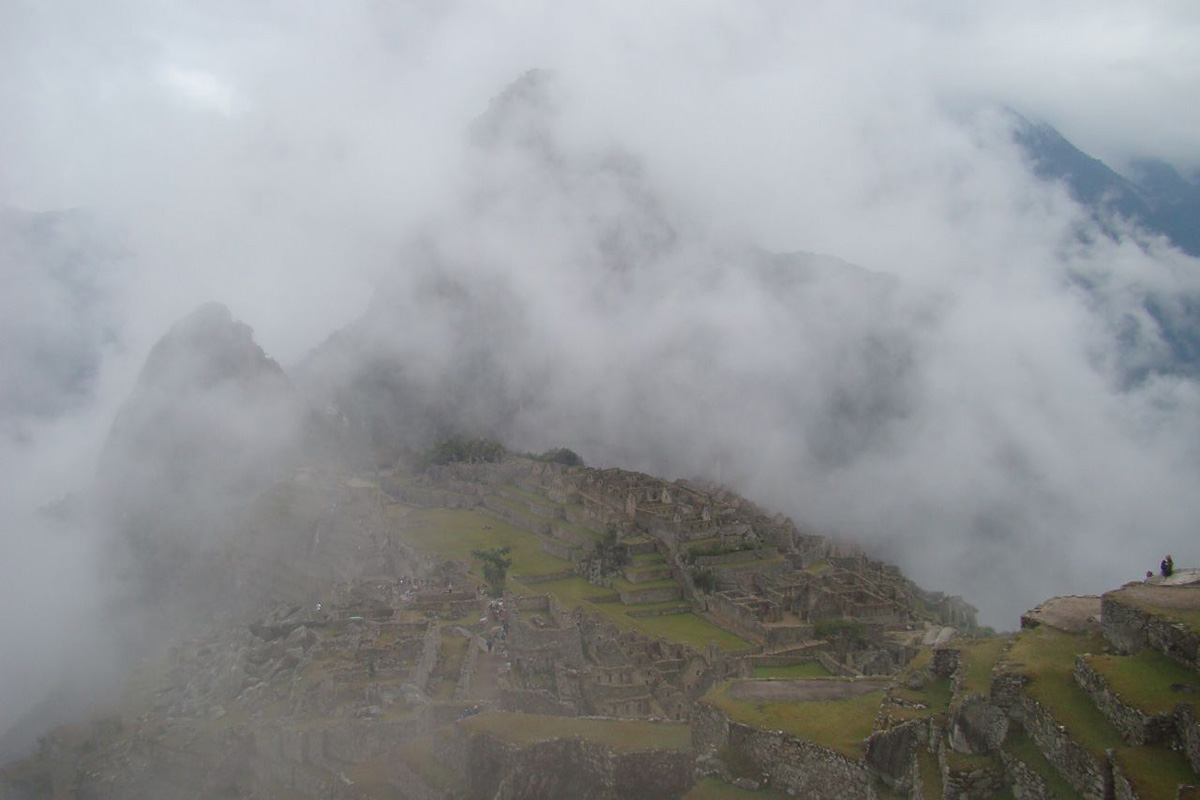
Mist hanging over the ruins. Photo by An en Alain on Flickr.
Packing tips:
The shoulder seasons, April, October, and November, give you the best of both worlds. There is a higher chance of rain than during the dry season but not much more than a few scattered showers. Plus you have much fewer people.
So, is there a difference between visiting during April as opposed to October/November? Definitely. April lies just after the rainy season so you can expect to find the mountains much lusher. The landscape in October and November will be more dry and brown after so many months with little rain.
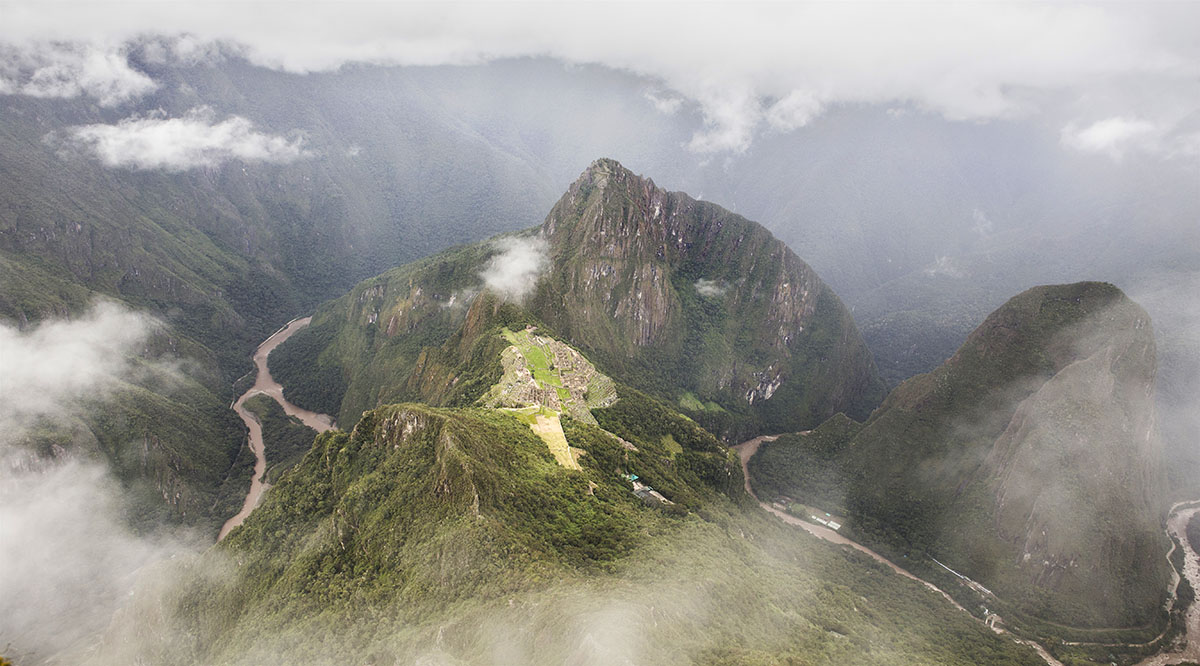
View from Machu Picchu Mountain of the lush green landscape surrounding the ruins. Photo by Peru For Less.
If you want to be on the more cautious side in regards to the weather, you can still plan for some extra time at Machu Picchu as you would with the rainy season. If you’re lucky, you may even get both those bright sunny photos of the ruins as well as the dramatic clouded photos. In any case, your backgrounds may have a handful of people in them, but it will be easier to get a nice shot without having to wait for tour groups to go by.
Packing tips:
If you are planning to climb one of the two peaks within the ruins, Huayna Picchu or Machu Picchu Mountain, it’s best to travel during the dry season or the shoulder seasons for the best conditions. Good weather is especially important for Huayna Picchu because the steep, stone Inca steps can get slick in the rain, and you won’t be allowed to bring trekking poles into the ruins for support.
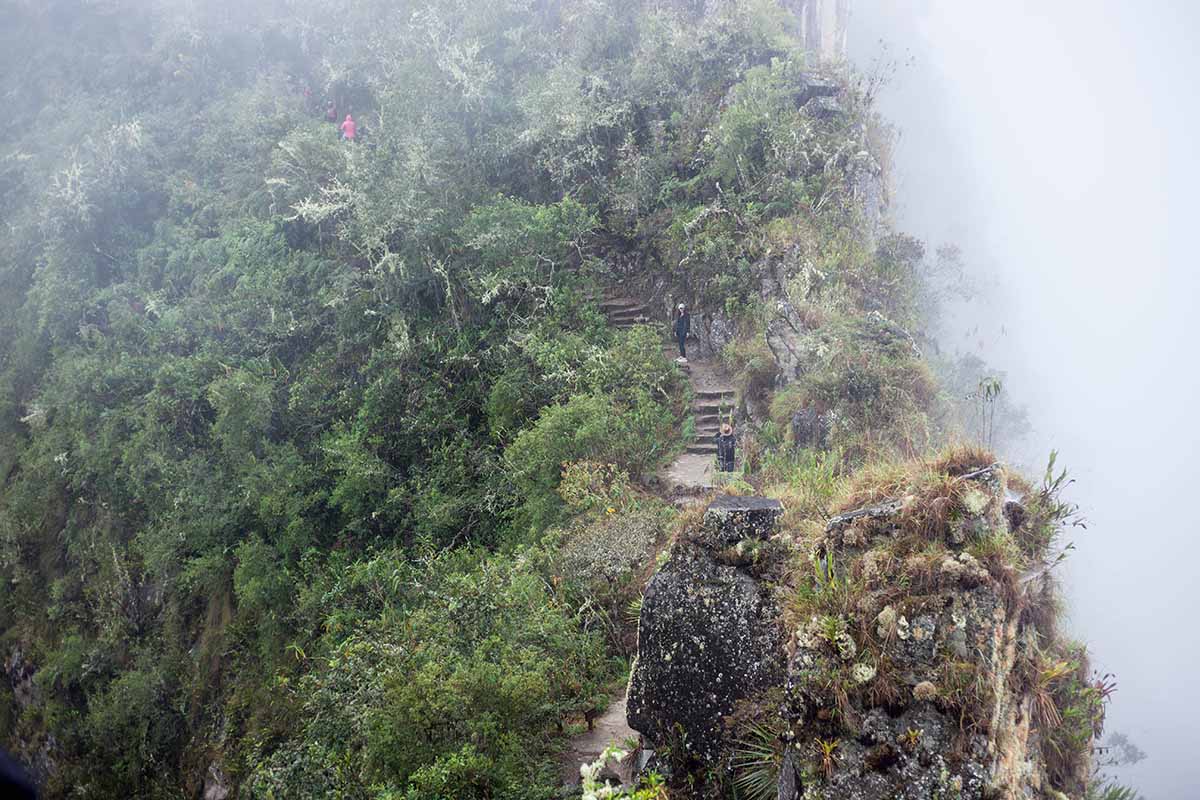
Fog over the trail leading up Machu Picchu Mountain. Photo by Peru For Less.
For multi-day hikes starting in Cusco and leading into Machu Picchu, you have a bit more leeway. The dry season, of course, offers the best hiking conditions because the trail will be dry and there’s less of a chance of your clothes getting wet. Just keep in mind that nights during the dry season will be the coldest of the year, hovering around freezing at the highest altitudes.
If you can’t travel during the dry season, shoulder seasons and even the tail ends of the rainy season are still fine for hiking given the proper gear. In fact, for those who are sensitive to extreme temperatures, these seasons may be better because the sun often won’t be as harsh during the day, and nights won’t be as cold.
However, it’s incredibly important to remember that no matter what time of year you decide to hike, you should always prepare for all kinds of weather. This means having hats and sunblock during the rainy season, as well as ponchos or rain jackets during the dry season. Treks in Peru like the Inca Trail, Salkantay, and Lares cover many different microclimates, including cloud forests and alpine tundra, so the weather will be much more unpredictable.
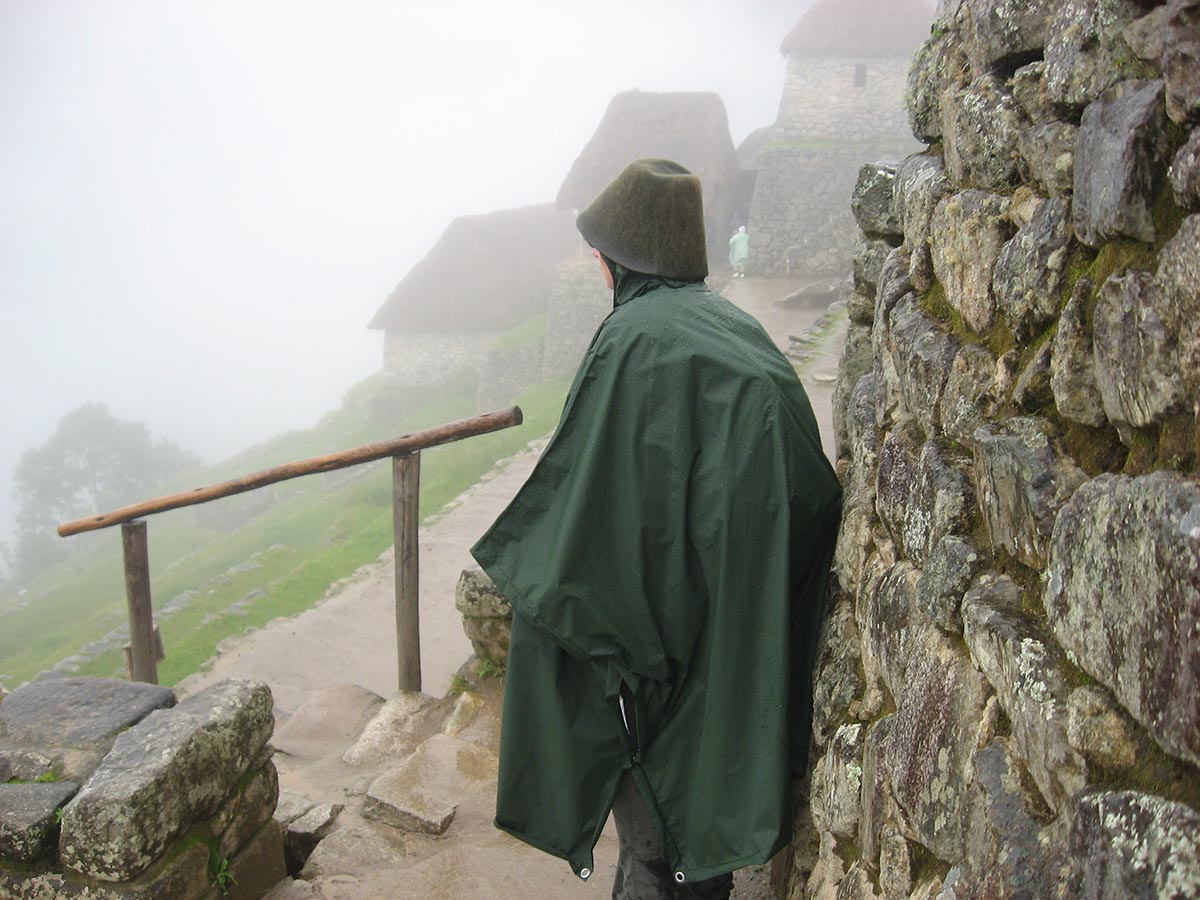
There is not bad weather, only bad clothes! Photo by Paul Comstock on Flickr.
Note: The Inca Trail is completely closed during the month of February for maintenance.
January is the peak of the rainy season at Machu Picchu. The average rainfall is 8.9 inches for the entire month. The stones at the ruins, as well as hiking paths, can be pretty slippery at this time. However, it will only rain about 18 days out of 31. This is also one of the warmest months with an average high of 68F and an average low of 46F.
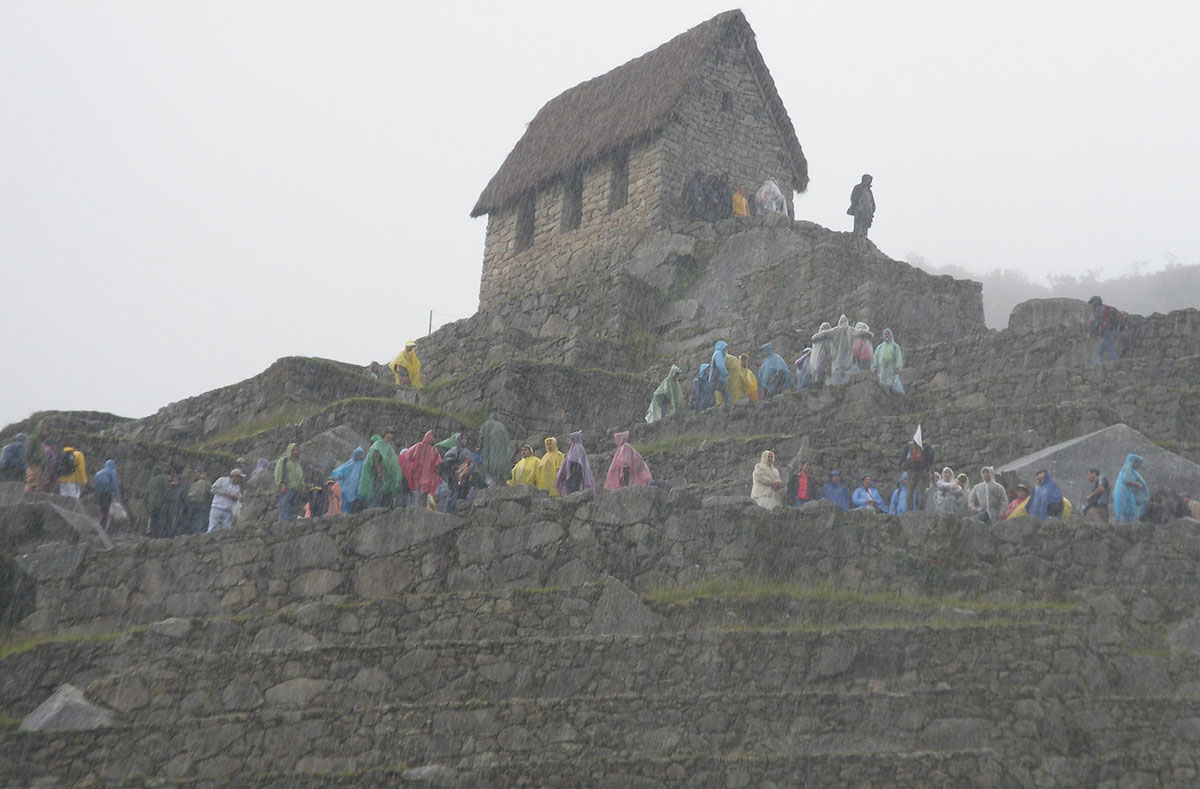 Visitors making their way through the ruins in the rain. Photo by Lorna Mitchell on Flickr.
Visitors making their way through the ruins in the rain. Photo by Lorna Mitchell on Flickr.
February also has high rainfall, averaging about 8.2 inches for the month. Like January, slick conditions make this a bad month for hiking. Also like January, the bright side is that it will only rain half the days of the month, and there are incredibly few tourists.
March is the tail end of the rainy season but still pretty wet with an average rainfall of 8 inches. It’s still best to avoid it if you’re looking to hike, especially since high altitude hikes like Rainbow Mountain can see snow that covers its unique colors.
By April, the amount of rainfall is nearly half (4.5 in) of that of March. It’s a perfect month for green scenery and still relatively few people at the ruins. Temperatures are very mild with an average high of 70F and an average low of 43F. Although not the absolute best month for hiking, you’ll be ok with the proper gear in case of showers.
May is the beginning of the dry season with only about 1.4 inches of rain. With the decrease in rainfall, you see a quick uptick in the number of visitors at the ruins! May to the end of the dry season is an excellent time for hiking.
If you’re planning to travel in May, be sure to plan your trip well in advance to get the best hotels and tours. This is also the first month to sell out for Inca Trail tickets!
June is typically the driest month of the year. The average rainfall is around 0.8 inches and only accounts for 3 days out of the month. However, temperatures can drop to 35F at night. The ruins will be pretty busy with visitors at this time given the nearly guaranteed nice weather.
Note that there’s an additional surge in visitors to the Cusco area for the days surrounding June 24th, which is the festival of Inti Raymi.
July is the second busiest month at Machu Picchu and normally the second driest. With only about 3 days of rain for the entire month, the chances of perfectly sunny weather are pretty good. Keep in mind, though, that this is the coldest month of the year with an average high of 68F but an average low of 34F.
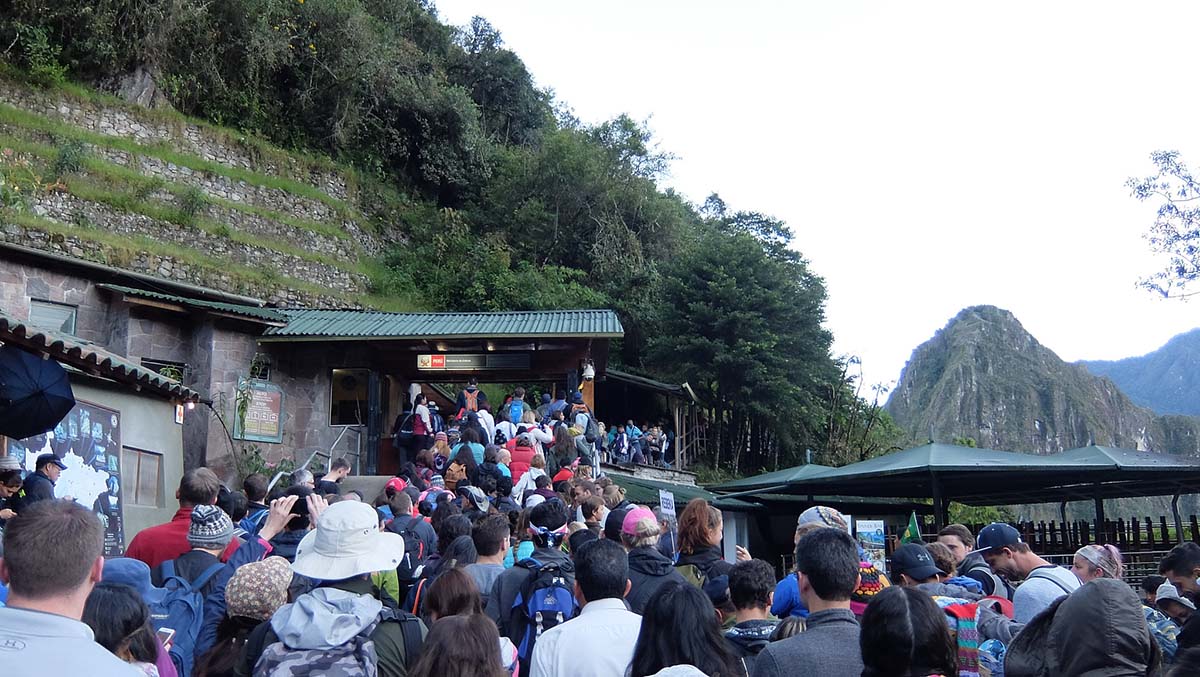
A packed Machu Picchu entrance. Photo by Kuruman on Flickr.
August is recorded as the busiest month of the year at Machu Picchu. The likelihood of rain is about the same as in May. Daily high and low temperatures are very similar to July.
September is still a busy month but not nearly as much as July and August. The average rainfall is only 2.2 inches, and rain occurs only about 5 days out of the month.
October can be pretty variable. For the most part, though, it has good weather with only 3.7 inches of rainfall. The average high temperature is about 72F, the warmest of the year, and the average low is about the same as January. By this time, crowds have begun to thin. In regards to scenery, after so many months of dry weather, it’s pretty brown in comparison to April.
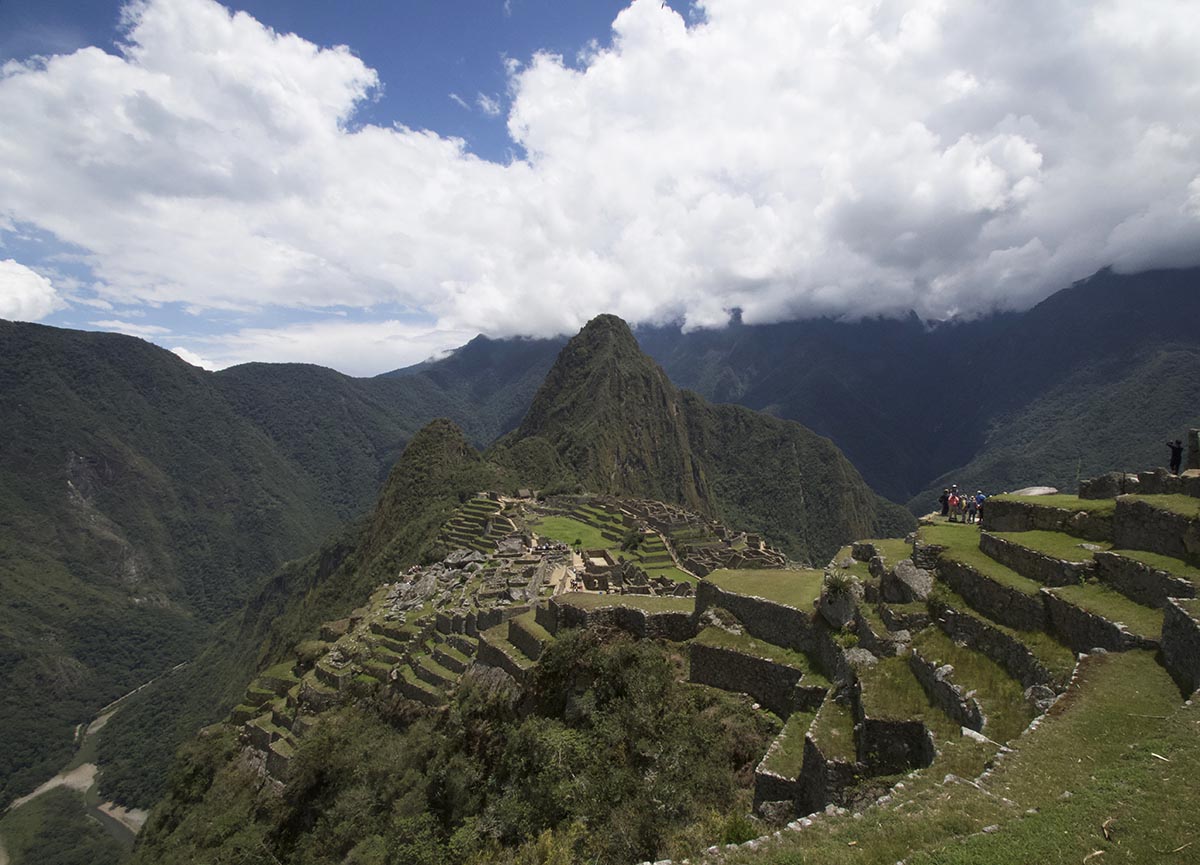
Cloudy day in October at Machu Picchu. Photo by author.
In November you start to get an inkling that the rainy season is approaching, with weather similar to that of April. This month probably has the lowest number of tourists out of all the shoulder season months. From this month to the end of the rainy season is not the best for hiking.
December is the beginning of the typical rainy season. Although rain clouds are probable—average rainfall is 7 inches with about 16 days of rain—there’s still a chance of getting some sunny days thrown in. The beginning of the month sees very few tourists. However, there is a pretty big peak in visitors for Christmas and New Year’s.
For more tips on traveling to Cusco during the holidays, click here.
It really does come down to your own personal preferences. If beautiful weather and bright, sunlit photos for your family travel albums are most important, then the dry season is definitely the best time to visit Machu Picchu. If you don’t mind a few rain showers and are very much crowd averse, try sometime in the rainy season. Ok with settling for the happy medium? The shoulder season months are for you!
Choosing when to travel can also depend on what other places you plan on visiting. Just because you may prefer one season for Machu Picchu doesn’t mean it will also be the best time to visit Peru’s other amazing destinations, like the Amazon rainforest or the Peruvian coastline.
Just remember that no matter what, visiting Machu Picchu is always a truly magical experience. If you aren’t able to go during your preferred season, that’s ok! There are advantages to every time of year, and with the right planning and preparation, your vacation will be one of your favorite trips of all time.
Still unsure about how best to plan your Peru trip? Just ask us!



Email: [email protected]
Sign up to receive our newsletter for great articles, stunning photos, and special deals.